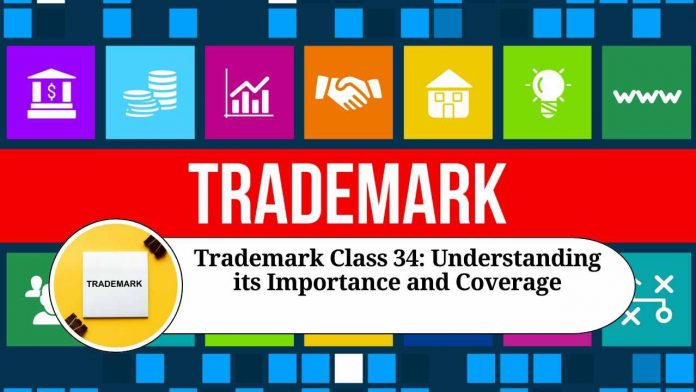Trademark Class 34: An Overview of Tobacco and Smoking Products
Trademark registration is an essential step for businesses to protect their brand identity and prevent unauthorized use of their brand name or logo. When filing a trademark application, it is important to identify the appropriate trademark class that corresponds to the goods or services provided by the business. One such trademark class is Class 34, which covers tobacco and smoking products. In this blog post, we will provide an overview of Class 34 and the goods it covers.
What is Trademark Class 34?
Trademark Class 34 is a classification under the Nice Classification system, which is an international system used to classify goods and services for the purposes of trademark registration. Class 34 covers tobacco and smoking products, including cigarettes, cigars, tobacco for smoking, tobacco substitutes, pipes, and smoking accessories such as lighters and ashtrays.
Goods Covered by Trademark Class 34
Class 34 includes a wide range of goods related to tobacco and smoking. Some of the specific goods covered by this class are:
- Cigarettes
- Cigars
- Tobacco for smoking
- Tobacco substitutes not for medical purposes
- Pipe tobacco
- Smokeless tobacco
- Electronic cigarettes
- Herbal cigarettes
- Lighters for smokers
- Matches
- Ashtrays
- Cigarette paper
- Cigarette filters
- Humidors
- Pipe cleaners
- Tobacco pipes
Goods Not Covered by Trademark Class 34
It is important to note that Class 34 does not cover certain goods related to smoking, such as pharmaceutical preparations for smoking cessation, which are covered by Class 5. Additionally, smoking accessories that are not specifically designed for use with tobacco or smoking products, such as general-purpose lighters or ashtrays, are not covered by Class 34.
Why is Trademark Class 34 Important?
For businesses that produce or sell tobacco and smoking products, registering their trademark under Class 34 is crucial to protect their brand identity and prevent others from using their brand name or logo in relation to similar goods. By registering their trademark under this class, businesses can also prevent others from using confusingly similar trademarks for similar goods, which can help to avoid customer confusion and protect the business’s reputation.
Trademark Class 34 is particularly relevant for businesses operating in the tobacco and smoking industry, as it covers a wide range of goods related to the production and consumption of tobacco products. For example, if a business manufactures and sells cigarettes, it would be important to register its trademark under Class 34 in order to prevent others from using a similar trademark for the same type of goods.
It is worth noting that the classification of goods under Class 34 is not limited to traditional tobacco products such as cigarettes and cigars. This class also covers electronic cigarettes, which have gained popularity in recent years as an alternative to traditional smoking. In addition, herbal cigarettes made from natural ingredients and smokeless tobacco products, such as chewing tobacco and snuff, are also covered by this class.
It is important for businesses to carefully review the list of goods covered by Class 34 before filing a trademark application. This is because the goods covered by this class are quite specific, and businesses must ensure that their goods fall within the scope of this classification. For example, a business that sells general-purpose lighters or ashtrays would not be covered by Class 34, as these products are not specifically designed for use with tobacco or smoking products.
Conclusion
In conclusion, registering a trademark under Class 34 is essential for businesses operating in the tobacco and smoking industry. By doing so, businesses can protect their brand identity and prevent others from using their trademark in relation to similar goods. However, it is important for businesses to carefully review the list of goods covered by this class and ensure that their goods fall within the scope of this classification before filing a trademark application.
Read more useful content:
Frequently Asked Questions (FAQs)
What is Trademark Class 34?
Trademark Class 34 is a classification under the Nice Classification system that covers tobacco and smoking products, including cigarettes, cigars, tobacco for smoking, tobacco substitutes, pipes, and smoking accessories.
Why is it important to register a trademark under Class 34?
For businesses operating in the tobacco and smoking industry, registering a trademark under Class 34 is crucial to protect their brand identity and prevent others from using their brand name or logo in relation to similar goods.
What types of goods are covered by Trademark Class 34?
Class 34 covers a wide range of goods related to tobacco and smoking, including cigarettes, cigars, tobacco for smoking, pipe tobacco, smokeless tobacco, electronic cigarettes, and smoking accessories such as lighters and ashtrays.
What types of goods are not covered by Trademark Class 34?
Class 34 does not cover smoking cessation products or general-purpose smoking accessories, such as lighters or ashtrays that are not specifically designed for use with tobacco or smoking products.
What is the process for registering a trademark under Class 34?
To register a trademark under Class 34, businesses must file a trademark application with the appropriate trademark office, providing details of the trademark and the goods or services that it will be used to identify.
Can a business register a trademark for multiple classes?
Yes, a business can register a trademark for multiple classes, depending on the goods or services that it provides.
How long does a trademark registration last?
The length of a trademark registration varies depending on the country or region in which it is registered. Generally, trademark registrations last for a period of 10 years, and can be renewed indefinitely.
What is the difference between a trademark and a patent?
A trademark is a symbol, word, or phrase used to identify and distinguish a business or product from others in the marketplace, while a patent is a legal right granted to inventors that protects their inventions from being copied or used without their permission.
How does registering a trademark benefit a business?
Registering a trademark provides businesses with legal protection and helps to establish their brand identity, making it easier for consumers to identify their products or services.
Can a business use a trademark without registering it?
Yes, a business can use a trademark without registering it, but registering a trademark provides greater legal protection and helps to establish the business’s brand identity in the marketplace.




















